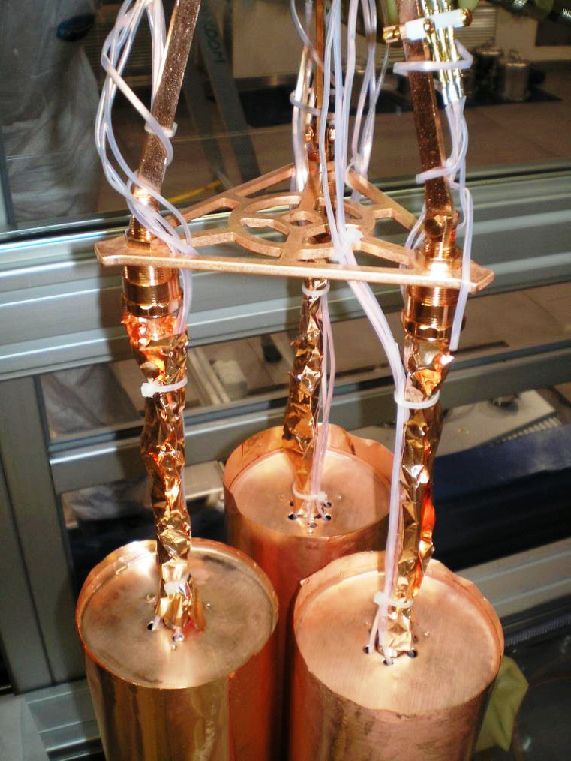Neutrinos are invisible but could carry as much mass as all other known forms of matter, traveling almost at the speed of light over fantastic distances. Their tiny masses have important consequences for the structures in the Universe and they are the driving element in the explosion of Supernovae.
But their most remarkable and important property was proposed by Ettore Majorana in the 1930s: Unlike all other particles that form the known matter around us, neutrinos may be their own antiparticles.
This has not been experimentally verified but scientists at the GERDA (GERmanium Detector Array) experiment, which is operated at the Laboratori Nazionali del Gran Sasso underground laboratory of the Istituto Nazionale di Fisica Nucleare in Italy, say they have obtained new strong limits for the neutrino-less double beta decay, which tests if neutrinos are their own antiparticles.
GERDA looks for double beta decay processes in the germanium isotope Ge-76 with and without the emission of neutrinos, the latter being a consequence of the Majorana properties. In normal beta decay, a neutron inside a nucleus decays to a proton, an electron and an antineutrino. For nuclei like Ge-76, normal beta decay is energetically forbidden, but the simultaneous conversion of two neutrons with the emission of two antineutrinos is possible and has been measured by GERDA recently with unprecedented precision.

This model of the GERDA experiment shows the onion-like structure which suppresses interfering signals from the environment. The germanium diodes in the center of the cryostat filled with liquid argon (–186°C) are to a larger scale. Credit: MPI for Nuclear Physics
This is one of the rarest decays ever observed with a half-life of about 2 x 1021 years, which is about 100 billion times longer than the age of the Universe.
If neutrinos are Majorana particles, neutrino-less double beta decay should also occur at an even lower rate. In this case, the anti-neutrino from one beta decay is absorbed as neutrino by the second beta-decaying neutron, which becomes possible if neutrinos are their own antiparticle.
In GERDA germanium crystals are both source and detector. Ge-76 has an abundance of about 8% in natural germanium and its fraction was therefore enriched more than 10-fold before the special detector crystals were grown. Searching for a needle in a haystack is trivial compared to the detection of double beta decay, since environmental radioactivity is a background occurring at a rate at least a billion times higher than double beta decay. The GERDA detector crystals and the surrounding detector parts were carefully chosen and processed. The observation of the extremely rare process requires in addition very delicate techniques to further suppress backgrounds from cosmic particles, natural radioactivity of the surroundings and even the experiment itself.
The scientists met this challenge by mounting the detectors in a huge vessel filled with extremely clean liquid argon, lined by ultra-pure copper, which in turn is surrounded by a 10-meter-diameter tank filled with highly pure water; the whole located underground below 1,400 meters of rock. Combining all these innovative and pioneering techniques they say it was possible to reduce the background to unprecedented levels.

Germanium detectors wrapped by a high-purity copper foil for radiation shielding. Credit: GERDA collaboration
Data taking started in the autumn of 2011, using 8 detectors the size of a tin can and weighing two kilograms each. Subsequently, 5 additional newly designed detectors were commissioned. Until recently, the signal region was blinded and the scientists focused on the optimization of the data analysis procedures. The experiment has now completed its first phase with 21 kg∙years of data accumulated.
The analysis in which all calibrations and cuts had been defined before the data in the signal region were processed, revealed no signal of neutrino-less double beta decay in Ge-76 which leads to the world’s best lower limit for the half-life of 2,1 x 1025 years.
Combined with information from other experiments, this result rules out an earlier claim for a signal by others. The new results from GERDA have interesting consequences for the knowledge on neutrino masses, extensions of the standard model of elementary particle physics, astrophysical processes and cosmology.
The next steps for GERDA will be to add additional newly produced detectors effectively doubling the amount of Ge-76. Data taking will then continue in a second phase after some further improvements are implemented to achieve even stronger background suppression.
GERDA Collaboration, The GERDA collaboration, M. Agostini, M. Allardt, E. Andreotti, A.M. Bakalyarov, M. Balata, I. Barabanov, M. Barnabe Heider, N. Barros, L. Baudis, C. Bauer, N. Becerici-Schmidt, E. Bellotti, S. Belogurov, S.T. Belyaev, G. Benato, A. Bettini, L. Bezrukov, T. Bode, V. Brudanin, R. Brugnera, D. Budjas, A. Caldwell, C. Cattadori, A. Chernogorov, F. Cossavella, E.V. Demidova, A. Domula, V. Egorov, R. Falkenstein, A. Ferella, K. Freund, N. Frodyma, A. Gangapshev, A. Garfagnini, C. Gotti, P. Grabmayr, V. Gurentsov, K. Gusev, K.K. Guthikonda, W. Hampel, A. Hegai, M. Heisel, S. Hemmer, G. Heusser, W. Hofmann, M. Hult, L.V. Inzhechik, L. Ioannucci, J. Janicsko Csathy, J. Jochum, M. Junker, T. Kihm, I.V. Kirpichnikov, A. Kirsch, A. Klimenko, K.T. Knoepfle, O. Kochetov, V.N. Kornoukhov, V.V. Kuzminov, M. Laubenstein, A. Lazzaro, V.I. Lebedev, B. Lehnert, H.Y. Liao, M. Lindner, I. Lippi, X. Liu, A. Lubashevskiy, B. Lubsandorzhiev, G. Lutter, C. Macolino, A.A. Machado, B. Majorovits, W. Maneschg, I. Nemchenok, S. Nisi, C. O'Shaughnessy, D. Palioselitis, L. Pandola, K. Pelczar, G. Pessina, A. Pullia, S. Riboldi, C. Sada, M. Salathe, C. Schmitt, J. Schreiner, O. Schulz, B. Schwingenheuer, S. Schoenert, E. Shevchik, M. Shirchenko, H. Simgen, A. Smolnikov, L. Stanco, H. Strecker, M. Tarka, C.A. Ur, A.A. Vasenko, O. Volynets, K. von Sturm, V. Wagner, M. Walter, A. Wegmann, T. Wester, M. Wojcik, E. Yanovich, P. Zavarise, I. Zhitnikov, S.V. Zhukov, D. Zinatulina, K. Zuber, G. Zuzel, Results of neutrinoless double beta decay of 76Ge from GERDA Phase, arXiv, July 16th 2013





Comments